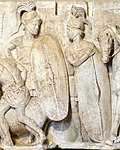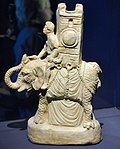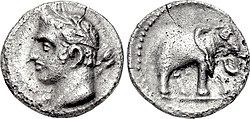Punic Wars
The Punic Wars were a series of conflicts fought between Rome and Carthage between 264 and 146 BC.[1] They were probably the largest wars in the ancient world.[2] The term "Punic" comes from the Latin word Punicus (or Poenicus). This was the word the Romans used for the Carthaginians, due to their Phoenician ancestry.
The main cause of the Punic Wars was the clash of interests between the existing empire of Carthage and the expanding Roman Republic. What was at stake was control of the trading around the Mediterranean sea. Carthage lost the three wars.
- First Punic War 264 to 241 BC. Hannibal's father Hamilcar Barca was the Carthaginian general. Mainly fought on the sea and in Sicily. Rome came out on top as a dominant naval power, and Sicily was ceded to Rome.
- Second Punic War 218 to 201 BC. Hannibal was the Carthaginian general. Hannibal crossed the Alps with war elephants in order to attack Rome on land, because they had put their fortifications on the coast, expecting a naval attack. Carthage lost when Romans invaded Africa. This war cemented Rome as the most powerful state in the Western Mediterranean.
- Third Punic War 149 to 146 BC. Carthage lost again and their city was completely destroyed by the Romans.
Context
Carthage was a trading nation founded by Phoenicians. It was the dominant sea power in the western Mediterranean. It was a maritime empire, in contrast to the land-based Roman empire. The Romans decided that having Sicily under complete Carthaginian control would be a threat to their growing empire. The Romans feared the independent nation of Syracuse would collapse, allowing the Carthaginians to threaten the nation of Rome. The resulting decisions resulted in a series of wars which lasted over a hundred years, and ended in the utter destruction of Carthage.
Punic Wars Media
Polybius[3] Detail from the second century BC Ahenobarbus relief showing two Roman foot-soldiers The corvus, the Roman ship boarding device Roman statuette of a war elephant recovered from Pompei[4] A Carthaginian quarter-shekel, dated 237–209 BC, depicting the Punic god Melqart (who was associated with Hercules/Heracles). On the reverse is an elephant; possibly a war elephant, which were linked with the Barcids.[5]
References
- ↑ Chris Scarre, "The Wars with Carthage," The Penguin Historical Atlas of Ancient Rome (London: Penguin Books, 1995), 24-25.
- ↑ Goldsworthy, The Punic Wars, p. 13
- ↑ Melfi 2017, p. 192.
- ↑ Sogliano 1897, pp. 23–27.
- ↑ Miles 2011, pp. 226–227.
Other websites
- Punic Wars Timeline Archived 2008-02-24 at the Wayback Machine










